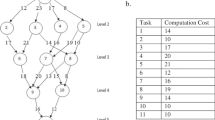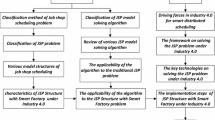Abstract
We put forward an optimal disk schedule withn disk requests and prove its optimality mathematically. Generalizing the idea of an optimal disk schedule, we remove the limit of n requests and, at the same time, consider the dynamically arrival model of disk requests to obtain an algorithm, shortest path first-fit first (SPFF). This algorithm is based on the shortes path of disk head motion constructed by all the pendent requests. From view of the head-moving distance, it has the stronger globality than SSTF. From view of the head-moving direction, it has the better flexibility than SCAN. Therefore, SPFF keeps the advantage of SCAN and, at the same time, absorbs the strength of SSTF. The algorithm SPFF not only shows the more superiority than other scheduling polices, but also have higher adjustability to meet the computer system’s different demands.
Similar content being viewed by others
References
Gibson G, Meter R. Network Attached Storage Architecture.Communications of the ACM, 2000,43(11):37–45.
Yasuda Y, Kawamoto S, Ebata A,et al. Concept and Evalution of X-NAS: a Highly Scalable NAS System.Proceedings of the 20 th IEEE/11th NASA Goddard Conference on Mass Storage Systems and Technologies, http://ieeexplore. iee.org, June 2003.
Chen Yong, Ni L M, Yang Ming-yao,et al. CoStore: a Serverless Distributed File System Utilizing Disk Space on Workstation Clusters.http://ieexplore.iee.org July 2002.
Geist R, Daniel S. A Continuum of Disk Scheduling Algorithms.ACM Transactions on Computer Systems, 1987,5 (1):77–92.
Stallings W.Operating Systems: Internals and Design Principles. Third Edition. Beijing: Tshinghua University Press, 1998.
Kuo T W, Rao J S, Lee V C S,et al. Real-Time Disk Scheduling for Block-Stripping I20 RAID. 13th Euromicro Conference on Real Time: http://ieexplore.ieee.org, June 2001.
Emilda S, Jacob L, Ovidiu D,et al. Flexible Disk Scheduling for Multimedia Presentation Servers.http://ieeexplore. ieee.org, July 2002.
Chang Ray-i, Shih Wei-kuan, Chang Ruei-chuan. Deadline-modification-SCAN with Maximum-scannable-groups for Multimedia Real-time Disk Scheduling.http://ieexplore. ieee.org, May 1998.
Chiuch Tzi-cker. Stonehenge: a Fault tolerant Real-time Network-attached Storage Device.Hot Intercomects 9, http://ieeexplore.ieee.org, Jan 2001.
Salem M M, Abd El-Gwad A O, Harb H M,et al. Computers Operating Systems: V-SSTF Dynamic Disk scheduling Technique.http://ieeexplore.iee.org, June 1991.
Author information
Authors and Affiliations
Additional information
Foundation item: Supported by the National Natural Science Foundation of China (60373088)
Biography: HU Ming (1961-), male, Ph.D., research direction: the computer network architecture and higher performance storage.
Rights and permissions
About this article
Cite this article
Ming, H. A disk scheduling algorithm: SPFF. Wuhan Univ. J. Nat. Sci. 10, 983–987 (2005). https://doi.org/10.1007/BF02832452
Received:
Issue Date:
DOI: https://doi.org/10.1007/BF02832452
Key words
- NAS (network-attached storage)
- clusters
- dis cheduling algorithm
- shortest path first-fit first SPFF
- SSTF (Shortest Service Time First)
- SCAN




